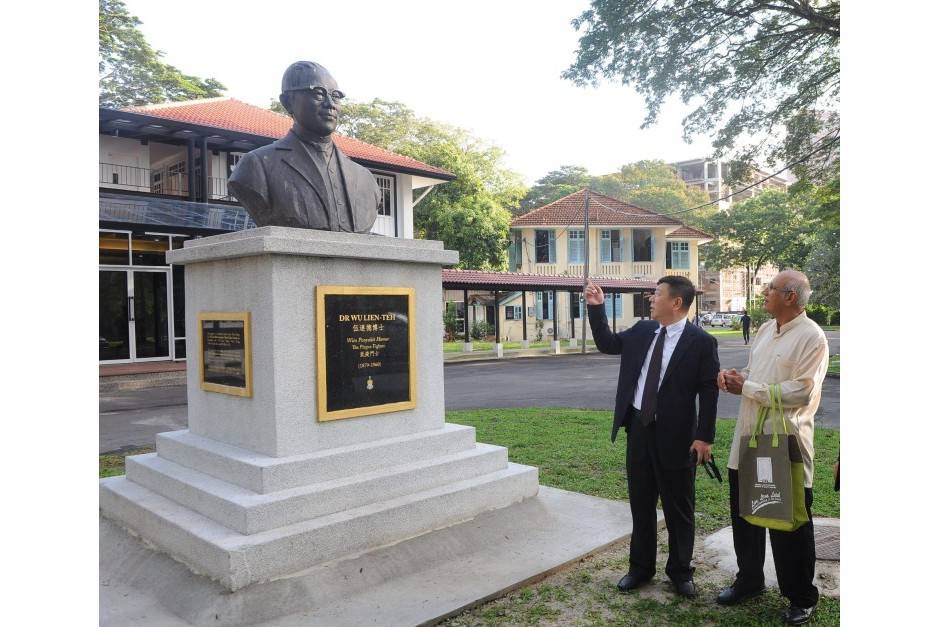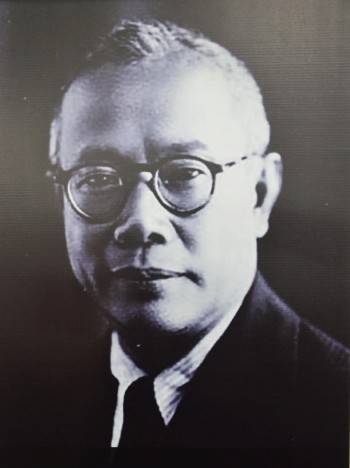
Dr Wu Lien-Teh Society chairman Datuk Dr Anwar Fazal (second from left) looking at Dr Wu’s bust which is located in front of the Penang Institute on Brown Road. – ASRI ABDUL GHANI/The Star
HIS name does not exist in our school history books and he has never been accorded the recognition that he truly deserves – and what’s more, he was a Malaysian.
In the fall of 1910, a pneumonic plague which originated in Russian Siberia, broke out in Harbin, the north eastern region of China. The epidemic spread so quickly that within four months, it claimed 60,000 lives.

Dr Wu Lien Teh (pic), a Penangite, was given the job to find a vaccine to curtail the virus, which broke out in October 1910 and lasted till March the following year.
This is perhaps a good time to talk about Dr Wu as China and the world race against time to find a cure for the deadly novel coronavirus.
It is an appropriate time to honour a Malaysian who fought a plague that killed even more people in China then.
Dr Wu was born in Penang on March 10,1879 and, at 17, went to England to study at Emmanuel College, at the University of Cambridge.
He became the first ethnic Chinese to study medicine in the prestigious university.
According to an article in the Penang Monthly by Koh King Kee, the Penang Free School boy completed his medical degree two years ahead of requirement and won all possible prizes and scholarships in a class of 135 students.
”He pursued a postgraduate study of malaria at the Liverpool School of Tropical Medicine, and bacteriology at the Hygiene Institute of Halle in Germany and Institute Pasteur in Paris. He was the first student of Chinese decent to graduate with an MD from Cambridge University,” Koh wrote.
”After his arrival at Harbin, Dr Wu performed the first-ever post mortem exam in China on a Japanese woman who died from the epidemic. He discovered Yersinia Pestis in the body tissues and further concluded that the epidemic was pneumonic plague, which could be transmitted by human breath or sputum.
”This was contrary to the general idea that plague could only be transmitted by rats or fleas and could not be transmitted from person to person. His idea surprised all of his scientific peers and was met with widespread disbelief,” according to an article, published by US National Institute of Health, National Library of Medicine.
The article further notes that Dr Gerald Mesny, a prominent French doctor, was one of those who doubted Dr Wu’s views. Dr Mesny himself died of pneumonic plague several days later, after refusing to wear a mask, succumbing to the epidemic infection. His death shocked the international community then.
At the same time, Dr Wu convinced the Russian and Japanese railway authorities to cease the operation of all trains in 1911. These efforts cut off all transportation and contained further transmission of the disease in Northern-East China. Nonetheless, the death toll in Harbin continued to rise as the corpses of those who died of the epidemic served as a perfect “incubator” for the infection to spread.
Dr Wu sent a petition for the bodies of the deceased to be cremated and some 3,000 corpses and coffins were gathered and cremated.
No further infection was reported as of March 31,1911. The deadly disease had vanished by the time the Chinese New Year arrived, the article said.
”On the advice of Dr Wu, the International Plague Conference was held in Mukden from April 3 to 28,1911.
Renowned epidemiologists and scientists from 11 countries, including the US, UK, Japan, Russia, and France attended.
Dr Wu was elected as president of the conference and his work on plague prevention was highly praised by all.
In fact, modern medical science was established in China soon after this conference ended.
Dr Wu, always the fighter at the forefront of the battle to prevent plague, successfully stamped out the recurring epidemic by 1921.
According to writers Zhongliang Ma and Yanli Li, Dr Wu, in later years, devoted much his efforts setting up hospitals and medical colleges and founded the Chinese Medical Society.
In 1931, after the Japanese invaded the north-eastern provinces of China, he left for Shanghai, where he set up the National Quarantine System.
He returned to Malaya with his family in 1937, following the commencement of the anti-Japanese war in China.
In his later years, after coming home, he wrote and published a 1959 autobiography in English, Plague Fighter: The Autobiography of a Modern Chinese Physician.
The book was reprinted in 2014 by Areca Books.
According to the writers, Dr Wu died at the age of 81 on Jan 20,1960. He was deeply mourned by the scientific and medical communities, as well as the world as a whole.
The Times of London commented on Jan 27,1960:
”By his death, the world of medicine has lost a heroic and almost legendary figure and the world at large, one of whom it is far more indebted to than it knows.”
He is recognised as the Father of Modern Chinese Medicine and an institute in named after him in Harbin.
”He is regarded as the first person to modernise China’s medical services and medical education. He is also the first Malaysian to be nominated for a Nobel Prize in Medicine.
”To honour him and to remember his contributions, bronze statues of Dr Wu Lien Teh, were erected at Harbin Medical University. He remains unforgotten and his work continues to serve us, such as occurred when SARS suddenly broke out in 2003.
”We owe much to Dr Wu, who saved many lives and whose contributions to modern medicine in China allow us to continue to do so today.
Thanks to Dr Wu’s great contribution, the Wu Lien-Teh Institute was opened on Dec 24,2015, with the objective of researching infectious diseases and sharing the resulting knowledge to everyone.
Dr Wu was accorded no less than 20 honorary doctorates from renowned institutions including the John Hopkins University, the Hong Kong University and the Imperial University of Japan.
At the Beijing University Hospital, his bronze statue is also up.
According to Koh, Dr Wu returned to Penang after his graduation but ended up fighting against the colonial system.
”There was a two-tier medical system in the British colonies, where only British nationals could hold the highest position of fully qualified medical officers or specialists, according to reports.
”But that did not deter him as he went on to become a scientist and an anti-opium advocate. He spent the first four years of his medical career at the Institute of Medical Research, researching beri-beri, which causes the body system to break down as a result of deficiency in Vitamin B.”
Koh wrote that Dr Wu was also very vocal on social issues and founded the Anti-Opium Association in Penang, which pitted him against powerful forces – the British colonists who approved the distribution of opium and triad-linked Chinese tycoons.
”He was soon framed by these connections, leading to a search and subsequent discovery of a mere one ounce of tincture of opium in his clinic, according to a posting in Wikipedia.
”It was quickly regarded as illegal, although he was a fully qualified medical doctor who had used the drug to treat opium patients.”
Dr Wu’s prosecution and appeal rejection attracted worldwide publicity, including an invitation from the Chinese government in Peking to take up the post of vice-director of the Imperial Army medical College in Tianjin.
Left with little options, Dr Wu travelled to Harbin, on the instruction of the foreign office in Beijing, to investigate an unknown disease, which turned out to be the deadly bubonic plague.
”But his career as a scientist was cut short by the war in 1937 when the Japanese attacked China.
In fact, his villa in Shanghai was bombed by the Japanese.
”He returned to Malaya where he opened a clinic in Ipoh at Brewster Road – which has been renamed Jalan Sultan Idris Shah.
”His social work continued where he collected donations for the setting up of the Perak Library, now the Tun Razak Library, in Ipoh.”
Koh wrote that despite keeping “a low-profile civilian life”, there were moments of drama in his life.
During the Japanese occupation, Dr Wu was kidnapped by Communist guerrillas and released only after a big ransom was paid.
”Two months later, it was the Japanese’s turn to arrest him on suspicion of supporting anti-Japanese forces. He was eventually cleared of the charge after a Japanese officer, who was his patient, testified to his innocence.”
He practised medicine until the age of 80 and like all Penangites, the state was his forever home.
He bought a house in Chor Sin Kheng Road in Air Itam, Penang, for his retirement and died on Jan 20,1960, aged 81, after suffering a stroke.
A road in Ipoh Garden South has been named after him while in Penang, a private road named Taman Wu Lien Teh is located near the PFS.
But the road in Ipoh remains wrongly spelled although the mistake has been highlighted to the Ipoh City Council. It remains spelled as Wu Lean Teh Road.
More importantly, it is a great injustice for his name to be omitted from our history textbooks.
He deserves to be forever remembered.
The Dr Wu Lien-Teh Society, headed by Datuk Anwar Fazal, was set up in 2013 to research, promote and support the legacy of this Malaysian legend.





